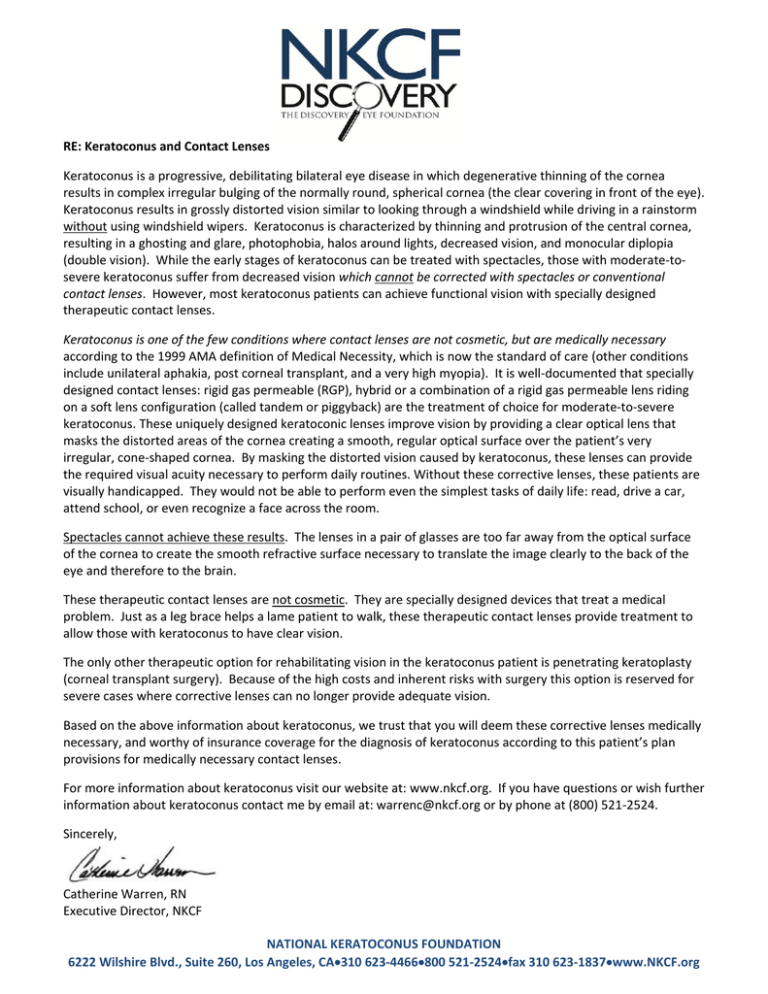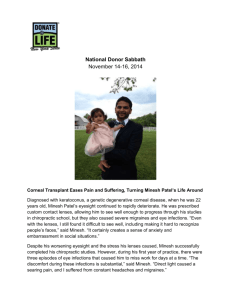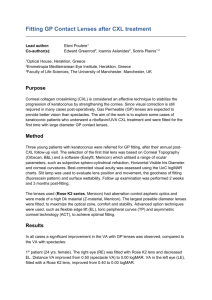RE: Keratoconus and Contact Lenses
advertisement

RE: Keratoconus and Contact Lenses Keratoconus is a progressive, debilitating bilateral eye disease in which degenerative thinning of the cornea results in complex irregular bulging of the normally round, spherical cornea (the clear covering in front of the eye). Keratoconus results in grossly distorted vision similar to looking through a windshield while driving in a rainstorm without using windshield wipers. Keratoconus is characterized by thinning and protrusion of the central cornea, resulting in a ghosting and glare, photophobia, halos around lights, decreased vision, and monocular diplopia (double vision). While the early stages of keratoconus can be treated with spectacles, those with moderate-tosevere keratoconus suffer from decreased vision which cannot be corrected with spectacles or conventional contact lenses. However, most keratoconus patients can achieve functional vision with specially designed therapeutic contact lenses. Keratoconus is one of the few conditions where contact lenses are not cosmetic, but are medically necessary according to the 1999 AMA definition of Medical Necessity, which is now the standard of care (other conditions include unilateral aphakia, post corneal transplant, and a very high myopia). It is well-documented that specially designed contact lenses: rigid gas permeable (RGP), hybrid or a combination of a rigid gas permeable lens riding on a soft lens configuration (called tandem or piggyback) are the treatment of choice for moderate-to-severe keratoconus. These uniquely designed keratoconic lenses improve vision by providing a clear optical lens that masks the distorted areas of the cornea creating a smooth, regular optical surface over the patient’s very irregular, cone-shaped cornea. By masking the distorted vision caused by keratoconus, these lenses can provide the required visual acuity necessary to perform daily routines. Without these corrective lenses, these patients are visually handicapped. They would not be able to perform even the simplest tasks of daily life: read, drive a car, attend school, or even recognize a face across the room. Spectacles cannot achieve these results. The lenses in a pair of glasses are too far away from the optical surface of the cornea to create the smooth refractive surface necessary to translate the image clearly to the back of the eye and therefore to the brain. These therapeutic contact lenses are not cosmetic. They are specially designed devices that treat a medical problem. Just as a leg brace helps a lame patient to walk, these therapeutic contact lenses provide treatment to allow those with keratoconus to have clear vision. The only other therapeutic option for rehabilitating vision in the keratoconus patient is penetrating keratoplasty (corneal transplant surgery). Because of the high costs and inherent risks with surgery this option is reserved for severe cases where corrective lenses can no longer provide adequate vision. Based on the above information about keratoconus, we trust that you will deem these corrective lenses medically necessary, and worthy of insurance coverage for the diagnosis of keratoconus according to this patient’s plan provisions for medically necessary contact lenses. For more information about keratoconus visit our website at: www.nkcf.org. If you have questions or wish further information about keratoconus contact me by email at: warrenc@nkcf.org or by phone at (800) 521-2524. Sincerely, Catherine Warren, RN Executive Director, NKCF NATIONAL KERATOCONUS FOUNDATION 6222 Wilshire Blvd., Suite 260, Los Angeles, CA310 623-4466800 521-2524fax 310 623-1837www.NKCF.org INSURANCE REIMBURSEMENT REQUEST FOR KERATOCONUS PROCEDURES AND MATERIALS Patient: ___________________________________ Date: _____/_____/____ Date of Birth: ______________________________ Policy #: __________________________________ I examined the above named patient on _____/_____/____. Based on the following information, this patient was diagnosed with keratoconus, an unusual ocular disease of the cornea (ICD-9 code: 371-6 0) as verified by corneal topography. Clinical history and measurements demonstrated the following: Best Spectacle VA OD_______/________, OS_______/________ Best Contact Lens VA OD _______/________, OS_______/________ Keratoconus (371.60) Keratoconus Stable (371.61) Keratoconus Unstable/Hydrops (371.62) Blurred Vision (368.8) Monocular Diplopia (368.15) Irregular Astigmatism (367.22) Hydrops (371.62) Photophobia (368.13) Corneal Scar unspecified (371.00) Corneal Striae (371.32) Corneal Fleischer’s Ring (371.10) (Iron Deposits Cornea) Corneal Thinning Distorted Keratometry Mires Cone-like corneal steepening measured by topographic mapping Keratometry Readings OD: _______/_______@________ OS: _______/_______ @________ Keratoconus is an ocular disease in which progressive, degenerative thinning of the cornea (the main refractive surface of the eye) results in a complex, irregular steepening of the corneal surface. Vision is affected by progressively reduced and distorted visual acuity that is not correctable with spectacles. The use of rigid gas permeable contact lenses is the primary accepted management to aid vision. The unique designs help create a regular optical surface in place of the irregular cornea. Often rigid contact lenses, unlike spectacles, can help to correct the vision of a keratoconic eye and provide the required visual acuity to legally drive a car and perform most job related tasks. Keratoconus, along with unilateral aphakia, post-corneal transplant, and very high myopia, is one of the conditions that make contact lenses medically necessary according to the 1999 AMA Definition of Medical Necessity. I have recommended that this patient be fitted with contact lenses to achieve the best vision possible. Based on the information provided above supporting a definitive diagnosis of keratoconus, these devices and associated services are a medical necessity. The only non-surgical method to provide adequate vision for the keratoconus patient is adjusting the deformed cornea to a regular front surface for the eye. This is accomplished by the fitting of a special rigid contact lens. If contact lenses cannot be worn, then the only alternative is corneal transplant surgery. I am requesting patient reimbursement for the following services: Corneal Topography, Unilateral or Bilateral (92025) Contact Lens Fitting (92072) Contact Lens, gas permeable, spherical, per lens (V2510) Contact Lens, gas permeable, scleral, per lens (V2531) Contact Lens, gas permeable, toric, prism ballast, per lens (V2511) Contact Lens, hydrophilic, spherical, per lens (V2520) Contact Lens Supply of material (99070) $____________________ $____________________ $____________________ $____________________ $____________________ $____________________ $____________________ Your time and effort on behalf of our patient is sincerely appreciated. I am available for further information, if needed. Sincerely, _____________________________________________________Date_________________ Doctor’s Signature __________________________________________________________________________ Doctor’s Name Office Address: _____________________________________________________________ ______________________________________________________________ ______________________________________________________________ Office Phone: ______________________________________________________________ Office Fax: ______________________________________________________________





